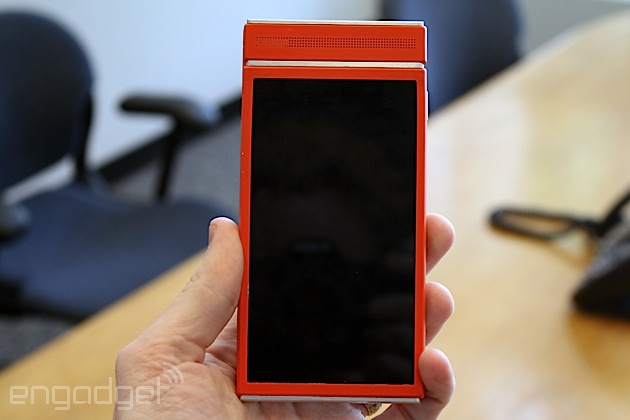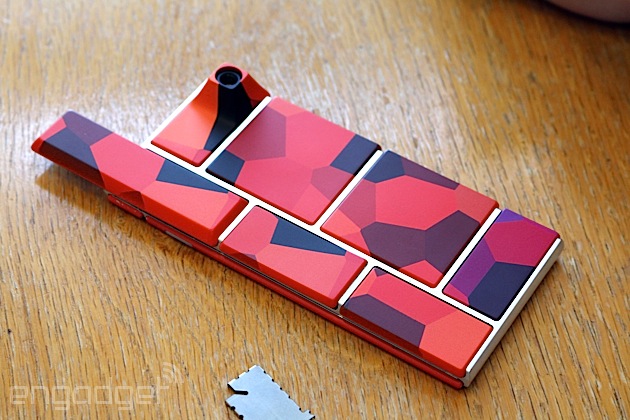

The night before Google's Advanced Technology and Projects (ATAP) division was supposed to show off the one and only functional Project Ara prototype to a room full of eager developers, someone dropped the phone and broke the display. At any other product reveal, this worst-case scenario would be a nightmare come true. Not to Google: The company made lemonade out of a lemon by turning it into a selling point for the modular smartphone. A year from now, painful situations like this might be easily fixed by simply buying a new display and swapping out the broken one.
Not that it would've made much of a difference if last night's fiasco never happened. Attendees at this week's Project Ara developer conference wouldn't have been able to boot up the prototype and play around with it like any typical smartphone -- in this case, "functional" is not the same as "functioning" -- but at least it would've made for a better presentation. Regardless of how it looked, however, we were able to briefly handle the Project Ara prototype and some of its first modules. To be clear, this is an extremely early model and there's a long way to go before it sees the light of day, but it at least allows us to get a good glimpse of what's to come over the next year as Ara continues to prepare for launch.
Project Ara brings the modular smartphone from concept to a reality; it almost seems like it should've made a cameo in The Lego Movie. The Ara consists of a metal endoskeleton, which is essentially the spine of the phone, and slots for replaceable components known as modules, which look a lot like tiles. (If you're reminded of Windows Phone when looking at the back, you won't be the first.) These tiled modules can include anything that makes your phone tick (processor, RAM, WiFi, power jack, baseband, display and battery, for instance), as well as plenty of other features like your camera, speakers and storage space. Each module will connect to the other working parts through capacitive interconnects, which are essentially wireless pads that are smaller than standard pins. Electropermanent magnets not only hold modules in place, but they also act as a toggle switch, which allows you to easily turn that element on and off. As you might already imagine, all modules can be swapped out at your convenience. ATAP plans to feature Ara in three different sizes, ranging from a smaller six-module option to a large-screened model with more modules.
At first blush, it almost sounds like this project only appeals to the same consumers that enjoy building their own computers from scratch, but ATAP insists that it'll transform emerging markets -- more specifically, the 5 billion people on Earth who own feature phones, but cannot afford to get anything more expensive. Today, the division announced that it's planning to ship a "Grey Phone," which is simply a prepackaged device that comes with only a screen, processor and WiFi module. From there, users can easily add and take away components as they see fit. It'll be relatively cheap -- the product would cost Google $50 to make, though retail price hasn't been determined yet -- and users on a tight budget can easily add or upgrade modules whenever they can afford to do so.
Longevity is another huge factor; whereas most smartphones today can barely make it through a two-year contract, Ara is meant to last for several years. This means it'll likely be much less expensive over the long run, and fewer phones will wind up in dumpsters.
According to ATAP, a device like Ara will also bring power of choice to consumer hands. Buying a smartphone often feels like a gamble -- a matter of sacrificing some features in favor of others. With Ara, you'll finally be able to determine exactly what kind of stuff you want in your phone. In essence, it sounds like Google's hoping to "disrupt" the traditional phone makers like Samsung, HTC and LG (as well as carriers), since the average consumer wouldn't need to go through those companies to buy a phone anymore.
When it comes to what kind of modules would be available, the sky's the limit. ATAP has already begun offering a development kit to anyone who wants to put together modules of their own, so there are plenty of possible use cases. One example shown was a pulse oximeter, featured in a long module that extended beyond the rest of the phone's chassis; there was a thick camera module that could easily be swapped out with different kinds of lenses; and we even listened to developers as they floated the idea of a credit card reader similar to a Square dongle. As of this week, it's now up to these partners and devs to explore the space and figure out how to make Ara successful.
Google's Project Ara wants to revolutionize the smartphone industry within a year
Photo Gallery
 goog set does it again
goog set does it againfirst day cop



 .
.